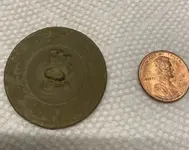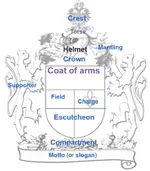Guys, while I agree this is likely not a livery button by any conventional definition, it’s not the presence or absence of a “roped border at the base” which defines it to be so or not.
That border is called a a “torse” and represents a wreath made from two lengths of fabric twisted together. Heraldically, the two pieces are of different colours… with one taking the metallic colour of the armorial shield. The most common combination is “argent & gules” (silver & red) and it’s usually shown as six twists of alternating tinctures, depicted linear or with a slight curvature.
Its purpose was that it sat on top of the helm of an armorial (usually a knight’s helmet but not always) to mask the join between the helm and the crest.
View attachment 2068698
When depicting an armorial (eg on a livery button or elsewhere for other identity reasons), it’s often only the crest which is depicted… not the full armorial. By convention, the torse is blazoned as part of the crest if the crest is shown in isolation from the rest of the armorial. However, not everyone who used a livery button had a full helmed armorial, or slavishly followed those heraldic conventions if they did. Also, sometimes what is depicted is not actually the armorial crest but an “emblem” associated with the family or organisation, for which the torse is inappropriate… although it may be added for decorative or pretentious reasons.
Consequently, there are numerous livery buttons with no torse, although the majority will have it.
I’ve never seen a button like this before but the imagery is curiously familiar and I have a nagging feeling that it has some allegorical meaning. Try as I might, I can’t place it.






